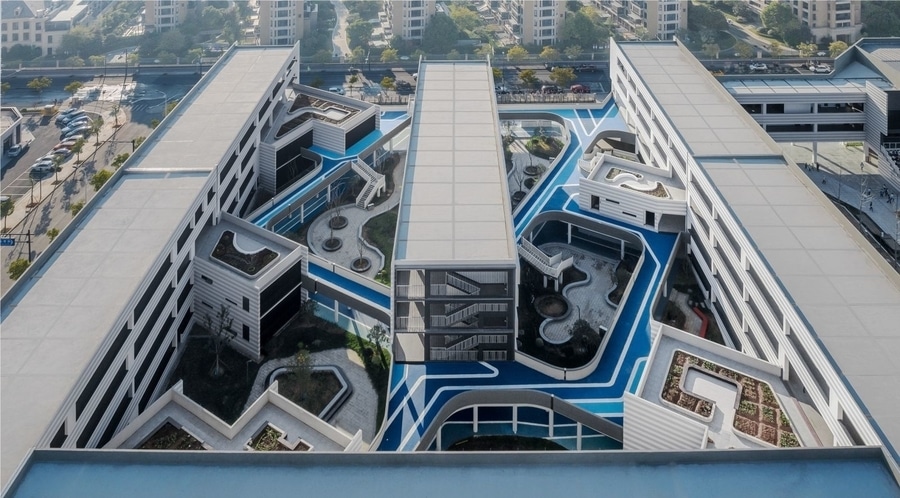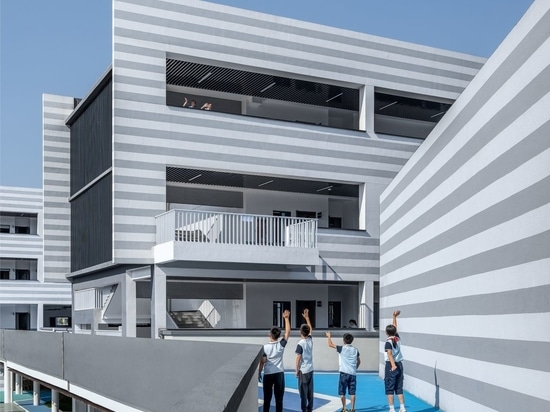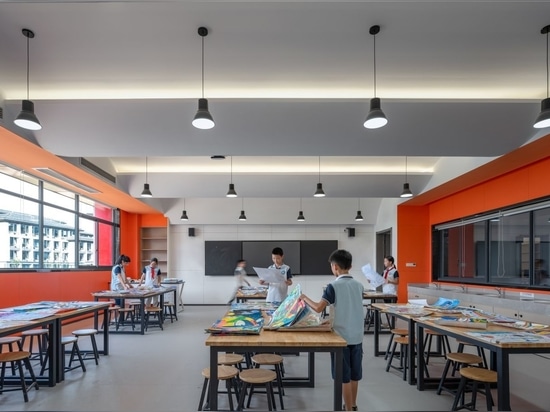
#PUBLIC ARCHITECTURE PROJECTS
Quzhou Xinhua No. 2 Primary School by LYCS Architecture
The project was constructed in accordance with the latest “Standardized Schools for Compulsory Education in Zhejiang Province” with the highest standard. The GFA of the school is approximated my 37,182 sqm, allowing 48 classes open at the same time.
Located in the rapidly developing Quzhou Smart New Town, the school is surrounded by residential areas on its south, north and west sides, and connects to the Xincheng Cultural and Educational District in the east where Quzhou Jingcai High School and Quzhou No. 1 Middle School are located. Our Xinhua No.2 Primiary School extends into the residential area like a “peninsula”.
The urban ecology at the intersection of different programmes is usually very noisy and busy with heavy traffic. Given that the environment, psychological status and behaviors are often affecting each other, children may feel helpless and insecure in the bustling intersection or the hustling city that is under construction. How to create a “safe haven” for the students and bring them a sense of belonging in the city?
Starting from the original intention of “guarding”, LYCS Architecture proposed the design strategy of “big city, small courtyard”, using large-scale buildings to enclose a “big city”for the children, and creating “small courtyards”with small-scale houses and verandas to allow children play around and experience the campus. Going west along Yingjiashan Road, there is a modern-style “city” of about 100 meters long comes into view.
On the white zebra-patterned facades, there are long horizontal red-framed windows and green traffic spaces. The interesting combination between simple gray-and-white stone paint and the red window frames makes the buildings’ volume less overwhelming from street views. The entrance of the “big city” , that is, the main entrance of the campus, opens to Xianxia Road, welcoming the students with an open manner.
Inside the campus, taking the main entrance as the axis, the north is the “moving area”. The playground and several sports venues keep the noises from Yingchuan East Road away, together with the administrative management, to create a sports park that can be shared with the community for different timeslots; the south part is the “quiet zone”, the teaching area, the “big city”.
The “big city” is about 300 meters long and is enclosed in a U shape. The general classrooms are distributed in the south part of the main building; classrooms for music lessons and labor skill are distributed in the east side of the building. The horizontal corridors connect both parts, allowing intercommunications between different programmes.
The U-shaped main building forms a boundary with the city and a huge introvert courtyard, creating a “small courtyard”, a micro park exclusively for the children. The circulation grid of the “Small Courtyards” was rotated by 30 degrees and then connected with the U shape of the “Big City”, creating a more dynamic journey within the linear corridors on the first and second floors.
The circulation for students is then changed from single line to a network with different scales and interweaving connections, offering highly diversified experiences of the campus. The corridors, which are pedestrian channels and public spaces, have greatly improved the playfulness of the journey. Running through the spaces under the corridor on the first floor, the view of the campus is constantly changing. Winding paths lead to seclusion.
The corridors organically connected various building blocks, while providing shelters for the students for outdoor activities in bad weathers. The outdoor veranda on the second floor allows students to run freely under the sun, it further expanded the scope of activities, and interact with the first floor vertically, forming a “doubled first floor”. Complementing the rotated axis are the small boxes placed in the large courtyard.
The box is only two-story high, together with the rooftop garden, they become a friendly destination for students after class. Both fun and educational spaces are inserted, including dancing and reading rooms. The small boxes and verandas fragment the large courtyard into pocket parks of different sizes. When students gathered in the parks between classes, they can play and relax in the beautiful landscape and acquire energy from the nature.
The corridor bridges and pocket parks on the first floor, the outdoor verandas on the second floor, and the boxes in the roof garden on the third floor together constitute a three-dimensional landscape in the campus. When the students are running along the verandas, meeting under the bridges, and gathering together in the parks, the rich experiences provided by the campus will constantly leave positive impact on the students’ behavior. Source by LYCS Architecture.
. Location: Quzhou, China
. Architect: LYCS Architecture
. Design Team: RUAN Hao, Zhan Yuan, Liu Dongyuanm, Guo Yanlan, Lu Xianhui(Architecture), Liu Dongyuan, Lu Xianhui, Xie Jie, Guo Yanlan, Ruan Wenjuan, Li Honghui, Shangli, Fang chen, Ruan Ziming, Xie Lianchun, Xu sheng, Wang Danlu, Xin xin, Wang Jianhong(Interior), Liu Donguyuan, Guo Yanlan(Lanscape)
. Cooperative Design Institute: TINSHINE Group
. Construction Contractor: XINHUA Construction Group
. Client: Quzhou West Investment Co. LTD
. Area: 37,182 m2
. Year: 2021
. Photographs: Wu Qing Shan, Courtesy of LYCS Architecture





